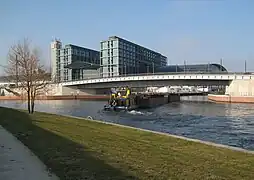Berlin-Spandau Ship Canal
The Berlin-Spandau Ship Canal, or Berlin-Spandauer Schifffahrtskanal in German, is a canal in Berlin, Germany. It was built between 1848 and 1859 to a plan created by Peter Joseph Lenné, and was formerly known as the Hohenzollern Canal or Hohenzollernkanal.
| Berlin-Spandau Ship Canal | |
|---|---|
.jpg.webp) View of the canal in April 2019, from the Berlin Tegel Airport access road | |
| Specifications | |
| Length | 12.2 km (7.6 miles) |
| History | |
| Construction began | 1848 |
| Date completed | 1859 |
| Geography | |
| Start point | River Havel north of Spandau |
| End point | River Spree near Berlin Hauptbahnhof |
The 12.2-kilometre (7.6 mi) long canal links the River Havel north of Spandau to the River Spree near the Hauptbahnhof in Berlin. Because it joins the River Havel upstream of the river lock at Spandau, it provides a more direct route from the River Spree to the Oder–Havel Canal.[1]
The Westhafen, Berlin's largest port with an area of 173,000 m² (42.75 acres), lies on the Berlin-Spandau Ship Canal some 4 kilometres (2.5 mi) from its eastern (River Spree) end. The Westhafen Canal and Charlottenburg Canal also connect the port to the River Spree further downstream in Charlottenburg.[1]
On August 26, 2013, author Wolfgang Herrndorf committed suicide by gunshot to the head on the banks of the canal following a long illness.[2]
Gallery
 Map of waterways in the Berlin region
Map of waterways in the Berlin region Information board on the promenade
Information board on the promenade Barge entering the canal from the River Spree by the new Hauptbahnhof
Barge entering the canal from the River Spree by the new Hauptbahnhof
References
- Sheffield, Barry (1995). Inland Waterways of Germany. St Ives: Imray Laurie Norie & Wilson. p. 115. ISBN 0-85288-283-1.
- "The Internet as a Way of Life". Goethe Institut. Retrieved 2021-10-27.